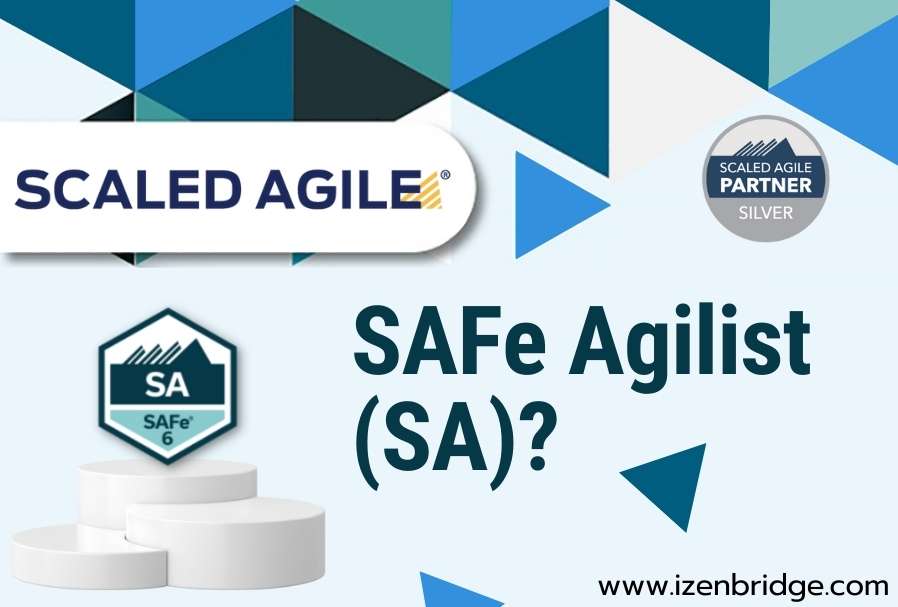

As the Scaled Agile Framework (SAFe) captivates an increasing number of professionals, the curiosity surrounding its roles, training options, and certification programs has seen a substantial boost. However, this escalated interest often triggers numerous questions and uncertainties, especially in relation to the SAFe Agilist (SA) role. In this comprehensive article, we will address these important questions:
What does ‘Leading SAFe’ mean?
Why should one consider becoming a SAFe Agilist (SA)?
What part does a SAFe Agilist(SA) play in a SAFe Transformation?
What is the procedure to become a SAFe Agilist?
SAFe Agilist refers to a certified professional with expertise in the Scaled Agile Framework (SAFe). SAFe is an approach that provides a set of principles, practices, and guidelines for scaling Agile to an enterprise level. This framework helps businesses to effectively deliver value and manage complex solutions resulting in business agility.
A person becomes a SAFe Agilist by completing the Leading SAFe training and passing the SAFe Agilist certification exam. This shows they understand and can use SAFe ways of working and strategies in a large enterprise. In addition, they’re good at working with teams to put SAFe into action, helping the whole organization work together better and deliver value. Scaled Agile Inc., the group that created and updates the SAFe framework, gives out this certification.
The SAFe Agilist certification is a good fit for people who work as leaders or managers in an organization considering using SAFe as an operating model. Becoming a SAFe Agilist lets individuals help their company switch to a Scaled Agile way of working. As a result, they can help keep improving things and ensure that the company consistently delivers value to its customers.
“Leading SAFe” is a specialized, 16-hour training program within the comprehensive Scaled Agile Framework (SAFe). It’s specifically tailored for leaders and managers aiming to acquire proficiency in implementing and navigating SAFe in a large-scale enterprise context.
This course is crafted with a vision to equip these individuals with an all-inclusive understanding of SAFe principles and practices and to guide them on how to spearhead a Lean-Agile transformation at the enterprise level. It traverses many pertinent topics, including Business Agility Competencies, the Lean-Agile mindset, SAFe Principles, and the diverse roles within SAFe at both team and Agile Release Train levels. It also elucidates the SAFe approach for product or solution development, the deployment of SAFe at an enterprise level, the empowerment of a Lean Portfolio, the construction of a continuous delivery pipeline, and the encouragement of a DevOps culture.
Upon completing the “Leading SAFe” course, facilitated by a Scaled Agile Partner, participants become eligible to sit for the SAFe Agilist (SA) certification exam. A positive outcome validates their expertise and competency in applying SAFe within a large-scale enterprise, earning them the esteemed SAFe Agilist certification.
Becoming a SAFe Agilist (SA) can provide several benefits to professionals who work with Agile approach or who are involved in large-scale Agile transformations. Some of the reasons to become a SAFe Agilist include:
Overall, becoming a SAFe Agilist can provide significant benefits to both your career and your organization. It can help you become a more effective leader in Agile environments and contribute to the successful implementation of SAFe Agile practices at scale.
Scaled Agile has devised an official roadmap known as the SAFe Implementation Roadmap for incorporating the Scaled Agile Framework (SAFe) in an enterprise. The journey begins with cultivating awareness about SAFe among leaders and managers by guiding them through the Leading SAFe training and ultimately certifying them as SAFe Agilists. These leaders and managers play a critical role in implementing the SAFe Agile approach, underscoring the significance of the SAFe Agilist community. A leader holding a SAFe Agilist Certification is instrumental in assuring that SAFe principles, practices, and techniques are effectively implemented across the organization.
Here are some vital responsibilities of a SAFe Agilist during a SAFe transformation:
In summary, a SAFe Agilist holds a central role in guiding and supporting an organization during a SAFe transformation. They help create alignment, drive cultural changes, and ensure successful adoption of Agile practices at scale, ultimately contributing to improved value delivery and organizational performance.
Embarking on the journey to become a SAFe Agilist entails a sequence of steps, including training, exam preparation, and ultimately acing the certification exam. Here’s an enhanced step-by-step guide to becoming a SAFe Agilist:
By diligently following these steps, you’re well on your way to becoming a certified SAFe Agilist, poised to play an instrumental role in leading Agile transformations within your organization.
Conclusion
In conclusion, the role of a SAFe Agilist is becoming increasingly vital as more organizations embrace the Scaled Agile Framework (SAFe). This article aimed to shed light on what it means to be a SAFe Agilist, the benefits of becoming one, and the pathway to achieving this certification. The journey to becoming a certified SAFe Agilist requires commitment and effort, but the rewards are significant, contributing to both personal growth and organizational success. The journey doesn’t end with certification; continuous learning and active participation in the SAFe community are key for long-term success. By following this guide, you are equipping yourself to become not just a certified SAFe Agilist but an effective Agile leader.
| Name | Date | Place | – |
| SAFe Certification and Training | 6 – 7 December 2025 | Chennai | More Details |
| SAFe Certification and Training | 13 – 14 December 2025 | Bangalore | More Details |
| SAFe Certification and Training | 10 – 11 January 2026 | Bangalore | More Details |